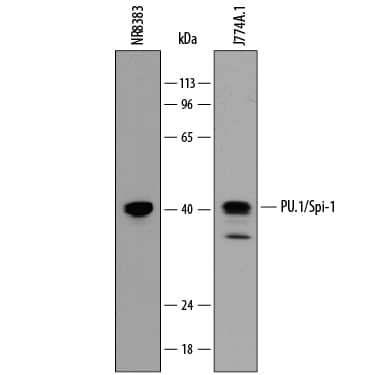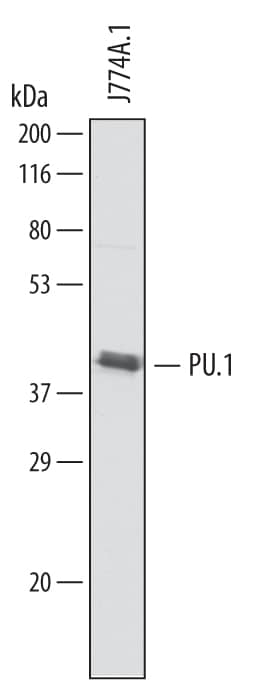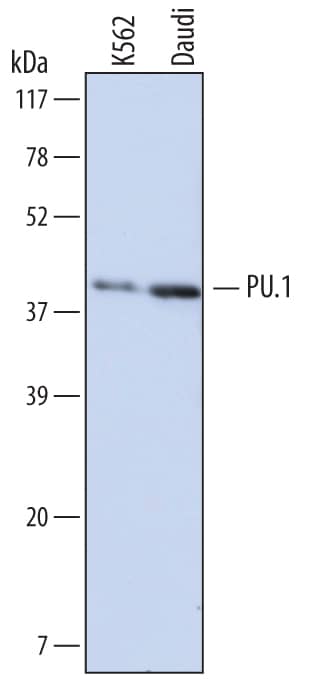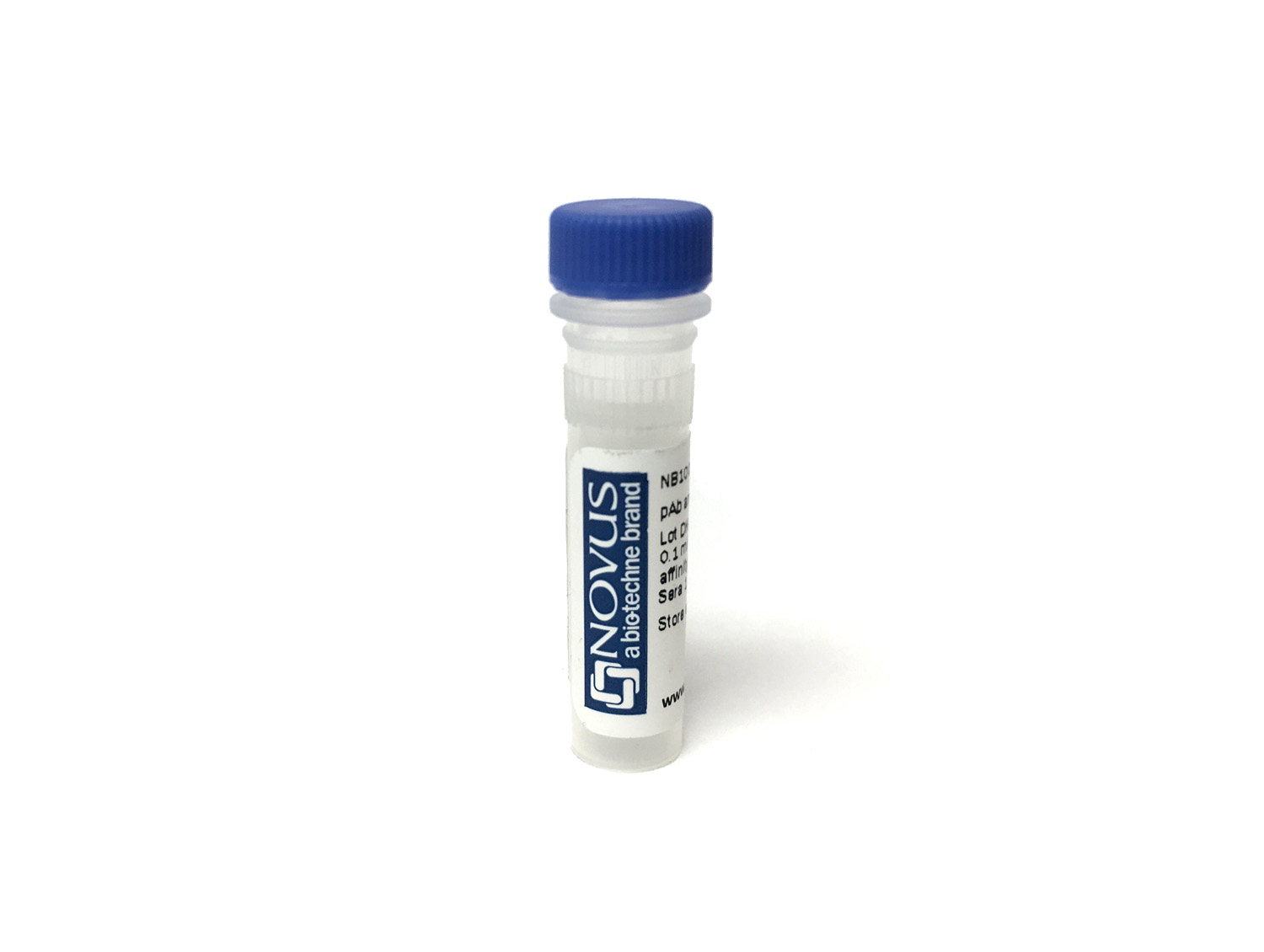PU.1/Spi-1 Products
PU.1 (Purine-rich nucleic acid binding protein 1; also 31 kDa transforming protein and SPI-1) is a member of the PU subfamily, ETS family of transcription factors. Although its predicted MW is 31 kDa, it appears to run anomalously high in SDS-PAGE at 40-45 kDa. PU.1 is a monomeric hematopoietic protein that regulates the differentiation of early myeloid and lymphoid progenitors. High PU.1 levels favor granulocyte and macrophage production, while low levels generate magakaryocytes, erythrocytes, T and B cells. Human PU.1 is 270 amino acids (aa) in length. It contains an N-terminal acidic/polyGln transactivation region (aa 34-99), a non-destabilizing PEST sequence (aa 117-165) and a C-terminal ETS DNA-binding domain (aa 170-253). PU.1 is phosphorylated on Ser146, allowing it to bind to Pip. Over aa 1-169, human PU.1 shares 88% aa identity with mouse PU.1.
166 results for "PU.1/Spi-1" in Products
166 results for "PU.1/Spi-1" in Products
PU.1/Spi-1 Products
PU.1 (Purine-rich nucleic acid binding protein 1; also 31 kDa transforming protein and SPI-1) is a member of the PU subfamily, ETS family of transcription factors. Although its predicted MW is 31 kDa, it appears to run anomalously high in SDS-PAGE at 40-45 kDa. PU.1 is a monomeric hematopoietic protein that regulates the differentiation of early myeloid and lymphoid progenitors. High PU.1 levels favor granulocyte and macrophage production, while low levels generate magakaryocytes, erythrocytes, T and B cells. Human PU.1 is 270 amino acids (aa) in length. It contains an N-terminal acidic/polyGln transactivation region (aa 34-99), a non-destabilizing PEST sequence (aa 117-165) and a C-terminal ETS DNA-binding domain (aa 170-253). PU.1 is phosphorylated on Ser146, allowing it to bind to Pip. Over aa 1-169, human PU.1 shares 88% aa identity with mouse PU.1.
| Reactivity: | Human |
| Details: | Mouse IgG2b Kappa Monoclonal Clone #PU1/2146 |
| Applications: | IHC, WB, ICC/IF, Flow, MA |
| Reactivity: | Human, Mouse, Canine, Bovine, Primate, +1 More |
| Details: | Rabbit IgG Polyclonal |
| Applications: | WB, Flow |
| Reactivity: | Mouse |
| Details: | Rat IgG2a Monoclonal Clone #823123 |
| Applications: | WB, ICC |
| Reactivity: | Human |
| Details: | Goat IgG Polyclonal |
| Applications: | IHC, WB, ELISA, Flow |
| Reactivity: | Human |
| Details: | Sheep IgG Polyclonal |
| Applications: | WB, CyTOF-ready, ICC, ICFlow |
| Reactivity: | Human |
| Details: | Rabbit IgG Polyclonal |
| Applications: | IHC, ICC/IF, ChIP |
| Reactivity: | Human |
| Details: | Mouse IgG2b Kappa Monoclonal Clone #PU1/2146 |
| Applications: | IHC, WB, ICC/IF, Flow, MA |
| Reactivity: | Mouse |
| Details: | Sheep IgG Polyclonal |
| Applications: | WB |
| Reactivity: | Human |
| Details: | Mouse IgG2b Monoclonal Clone #732322 |
| Applications: | WB, CyTOF-ready, ICFlow |
| Reactivity: | Human |
| Details: | Mouse IgG2B Monoclonal Clone #732322 |
| Applications: | WB, Flow, CyTOF-ready |
| Reactivity: | Human |
| Details: | Mouse IgG2b Kappa Monoclonal Clone #PU1/2146 |
| Applications: | IHC, WB, ICC/IF, Flow, MA |
| Reactivity: | Mouse |
| Details: | Sheep IgG Polyclonal |
| Applications: | WB |
| Reactivity: | Human |
| Details: | Sheep IgG Polyclonal |
| Applications: | WB, ICC/IF, Flow, CyTOF-ready |
| Reactivity: | Mouse |
| Details: | Rat IgG2A Monoclonal Clone #823123 |
| Applications: | WB, ICC/IF |
| Reactivity: | Human |
| Details: | Mouse IgG2b Monoclonal Clone #732322 |
| Applications: | ICFlow |
| Reactivity: | Human |
| Details: | Mouse IgG2b Monoclonal Clone #732322 |
| Applications: | ICFlow |
| Reactivity: | Human |
| Details: | Mouse IgG2b Monoclonal Clone #732322 |
| Applications: | ICFlow |
| Reactivity: | Human |
| Details: | Mouse IgG2b Monoclonal Clone #732322 |
| Applications: | ICFlow |
| Reactivity: | Human |
| Details: | Sheep IgG Polyclonal |
| Applications: | WB, CyTOF-ready, ICC, ICFlow |
| Reactivity: | Human |
| Details: | Sheep IgG Polyclonal |
| Applications: | WB, CyTOF-ready, ICC, ICFlow |
| Reactivity: | Human |
| Details: | Sheep IgG Polyclonal |
| Applications: | WB, CyTOF-ready, ICC, ICFlow |
| Reactivity: | Human |
| Details: | Sheep IgG Polyclonal |
| Applications: | WB, CyTOF-ready, ICC, ICFlow |
| Reactivity: | Human |
| Details: | Sheep IgG Polyclonal |
| Applications: | WB, CyTOF-ready, ICC, ICFlow |
| Reactivity: | Human |
| Details: | Sheep IgG Polyclonal |
| Applications: | WB, CyTOF-ready, ICC, ICFlow |
| Reactivity: | Human |
| Details: | Sheep IgG Polyclonal |
| Applications: | WB, CyTOF-ready, ICC, ICFlow |

![Western Blot: PU.1/Spi-1 Antibody (PU1/2146) [NBP2-75738] Western Blot: PU.1/Spi-1 Antibody (PU1/2146) [NBP2-75738]](https://resources.bio-techne.com/images/products/PU-1-Spi-1-Antibody-PU1-2146-Western-Blot-NBP2-75738-img0005.jpg)
![Western Blot: PU.1/Spi-1 Antibody [NBP2-27163] Western Blot: PU.1/Spi-1 Antibody [NBP2-27163]](https://resources.bio-techne.com/images/products/PU.1-Spi-1-Antibody-Western-Blot-NBP2-27163-img0005.jpg)


![Western Blot: PU.1/Spi-1 Antibody [NBP1-00135] Western Blot: PU.1/Spi-1 Antibody [NBP1-00135]](https://resources.bio-techne.com/images/products/PU.1-Spi-1-Antibody-Western-Blot-NBP1-00135-img0005.jpg)

![Immunocytochemistry/ Immunofluorescence: PU.1/Spi-1 Antibody [NBP2-33427] Immunocytochemistry/ Immunofluorescence: PU.1/Spi-1 Antibody [NBP2-33427]](https://resources.bio-techne.com/images/products/PU.1-Spi-1-Antibody-Immunocytochemistry-Immunofluorescence-NBP2-33427-img0003.jpg)
![Western Blot: PU.1/Spi-1 Antibody (PU1/2146)Azide and BSA Free [NBP2-75766] Western Blot: PU.1/Spi-1 Antibody (PU1/2146)Azide and BSA Free [NBP2-75766]](https://resources.bio-techne.com/images/products/PU-1-Spi-1-Antibody-PU1-2146-Azide-and-BSA-Free-Western-Blot-NBP2-75766-img0005.jpg)



![Product Feature: CoraFluor Probes for TR-FRET PU.1/Spi-1 Antibody [CoraFluor™ 1]](https://resources.bio-techne.com/images/products/af7124cl1_sheep-pu-1-spi-1-pab-corafluor-1-10920251415614.png)
![Product Feature: CoraFluor Probes for TR-FRET PU.1/Spi-1 Antibody [CoraFluor™ 1]](https://resources.bio-techne.com/images/products/af5870cl1_sheep-pu-1-spi-1-pab-corafluor-1-1411202512141924.png)